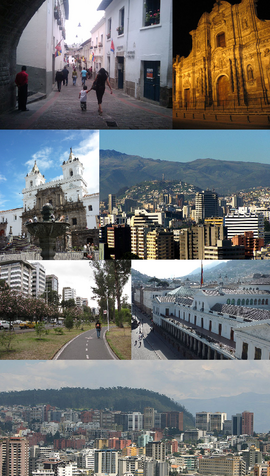Quito | |
|---|---|
| San Francisco de Quito | |
 Clockwise from top: La Ronda street, Church of the Society of Jesus, El Panecillo as seen from Northern Quito, Carondelet Palace, Central-Northern Quito, La Carolina Park and Church and Convent of St. Francis | |
| Nicknames: Carita de Dios (Little Face of God), Mitad del Mundo (Middle of the World), Luz de América (Light of the Americas) | |
Location of Quito within Ecuador | |
| Coordinates: 00°13′12″S 78°30′45″W / 0.22000°S 78.51250°W | |
| Country | Ecuador |
| Province | Pichincha |
| Canton | Metropolitan District of Quito |
| Spanish foundation | 6 December 1534 |
| Founded by | Sebastián de Benalcázar |
| Named for | Quitu |
| Urban parishes | 32 urban parishes |
| Government | |
| • Type | Mayor and council |
| • Governing body | Municipality of Quito |
| • Mayor | Pabel Muñoz |
| • Vice mayor | María Fernanda Racines |
| Area (approx.) | |
| • Capital city | 197.5 km2 (76.3 sq mi) |
| • Metro | 4,217.95 km2 (1,628.56 sq mi) |
| Elevation | 2,850 m (9,350 ft) |
| Population (2022)[2] | |
| • Capital city | 1,763,275 |
| • Density | 8,900/km2 (23,000/sq mi) |
| • Metro | 2,889,703 |
| • Metro density | 690/km2 (1,800/sq mi) |
| • Demonym | Quiteño[1] |
| GDP (PPP, constant 2015 values) | |
| • Year | 2023 |
| • Total | $33.9 billion[3] |
| • Per capita | $13,600 |
| Time zone | UTC−5 (ECT) |
| Postal code | EC170150 |
| Area code | (0)2 |
| Languages | Spanish |
| Climate | Cfb |
| Website | quito.gob.ec |
| Official name | City of Quito |
| Type | Cultural |
| Criteria | ii, iv |
| Designated | 1978 (2nd session) |
| Reference no. | 2 |
| Region | Latin America and the Caribbean |
Quito (Spanish pronunciation: [ˈkito] ⓘ; Quechua: Kitu), officially San Francisco de Quito, is the capital of Ecuador, with an estimated population of 2.8 million in its metropolitan area. It is also the capital of the province of Pichincha. Quito is located in a valley on the eastern slopes of Pichincha,[4] an active stratovolcano in the Andes.
Quito's elevation of 2,850 m (9,350 ft) makes it either the highest or the second highest capital city in the world. This varied standing is because Bolivia is a country with multiple capitals; if La Paz is considered the Bolivian national capital, it tops the list of highest capitals, but if Sucre is specified as the capital, then it is the second highest, behind Quito.[5][6]
Quito is the political and cultural center of Ecuador as the country's major governmental, administrative, and cultural institutions are located within the city. The majority of transnational companies with a presence in Ecuador are headquartered there. It is also one of the country's two major industrial centers—the port city of Guayaquil being the other one.
The date of its first habitation is unknown, but archaeological evidence suggests that it was first settled by sedentary populations between 4400 and 1600 BC.[7] In the late fifteenth century, the Inca Emperor Huayna Capac defeated the Quitu, the region's original inhabitants, and incorporated Quito into the Inca Empire, designating it into the capital of the Inca Empire's northern region. The Spanish conquest of the city in 1534 is the date most frequently cited as the city's official founding, making Quito the oldest capital in South America.
Quito's historic center is among the largest and best-preserved in the Americas.[8] In 1978, Quito and Kraków were the first World Cultural Heritage Sites declared by UNESCO.[8] Quito is the capital city closest to the Equator, which runs through the northern part of the metropolitan area in the parish of San Antonio.
- ^ , Encyclopædia Britannica, vol. VII (9th ed.), New York: Charles Scribner's Sons, 1878, p. 649
- ^ Citypopulation.de Population and area of Quito
- ^ "TelluBase—Ecuador Fact Sheet (Tellusant Public Service Series)" (PDF). Tellusant. Retrieved 11 January 2024.
- ^ "Guagua Pichincha". Instituto Geofísico, Escuela Politécnica Nacional. 27 April 2022.
- ^ "Contact Us." TAME. Retrieved on 14 March 2010.
- ^ La Paz is the administrative capital of Bolivia and is higher than Quito while Sucre is the constitutional capital of Bolivia and is lower than Quito.
- ^ "Encuentran indicios de los primeros habitantes de Quito, Ecuador". Red Historia (in Spanish). 16 November 2019. Retrieved 28 April 2022.
- ^ a b "City of Quito – UNESCO World Heritage". Whc.unesco.org. Retrieved 30 April 2010.




